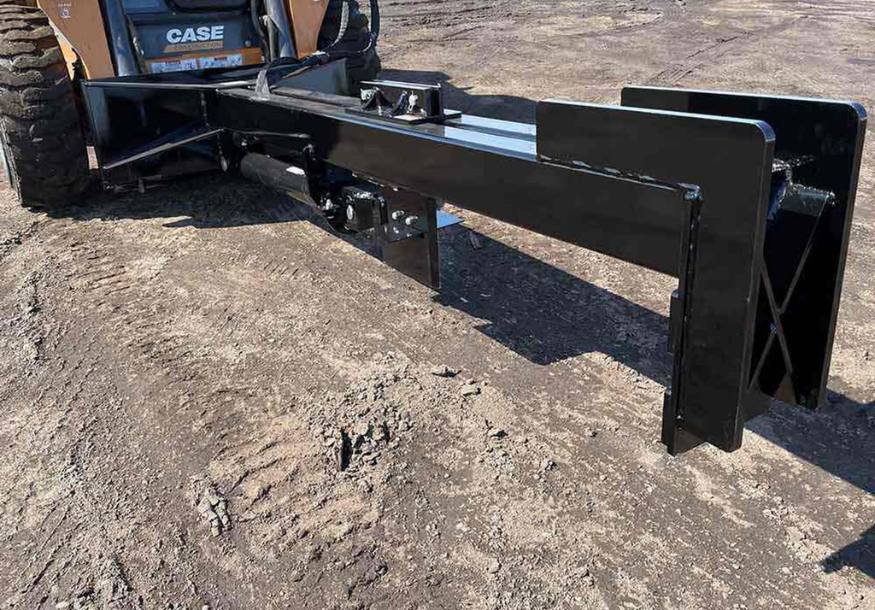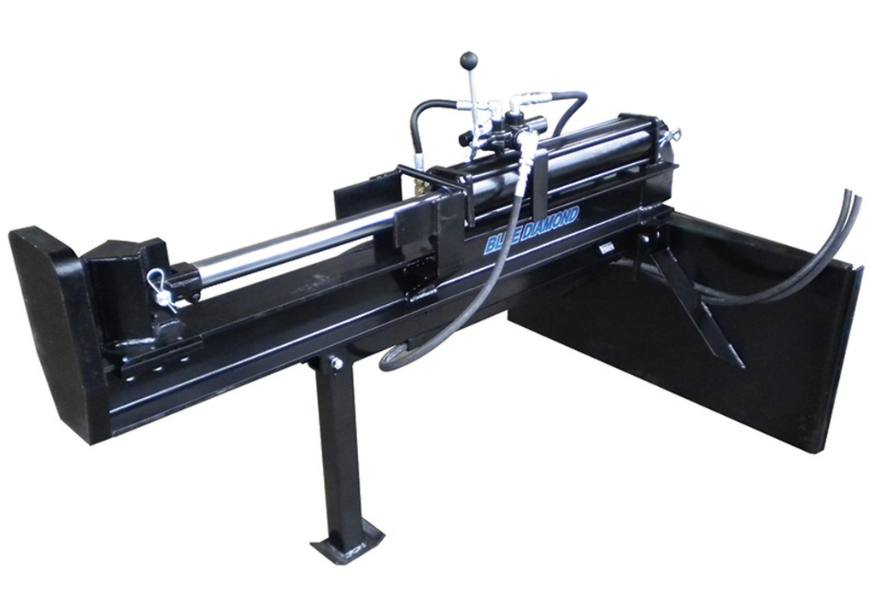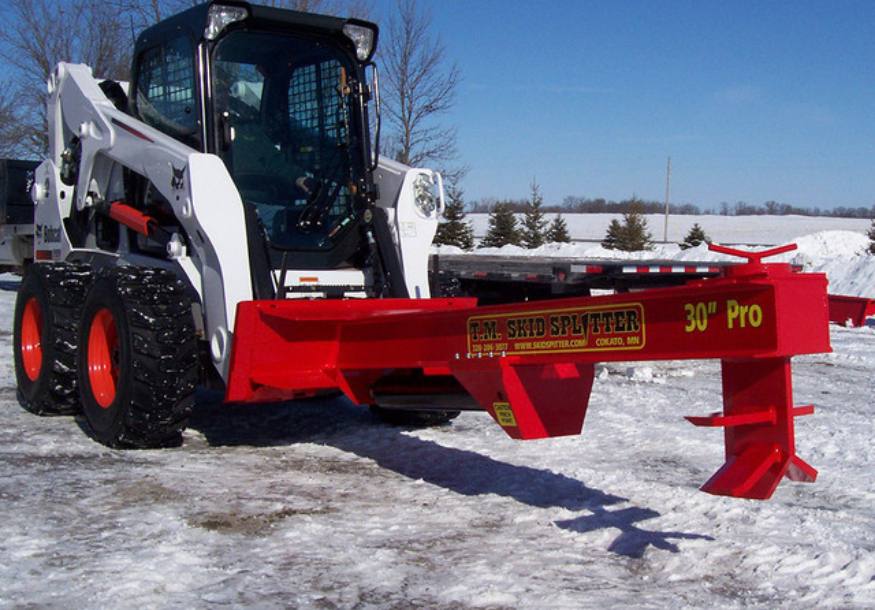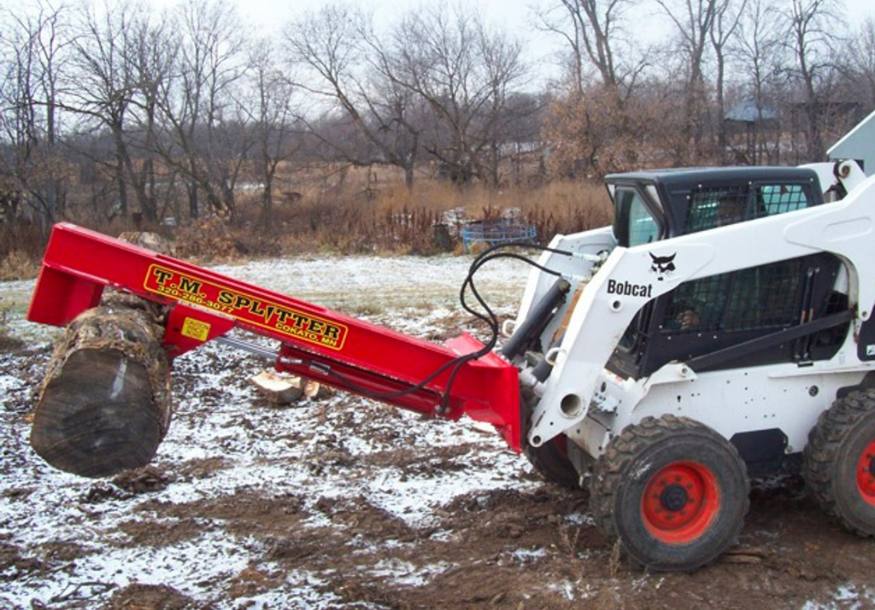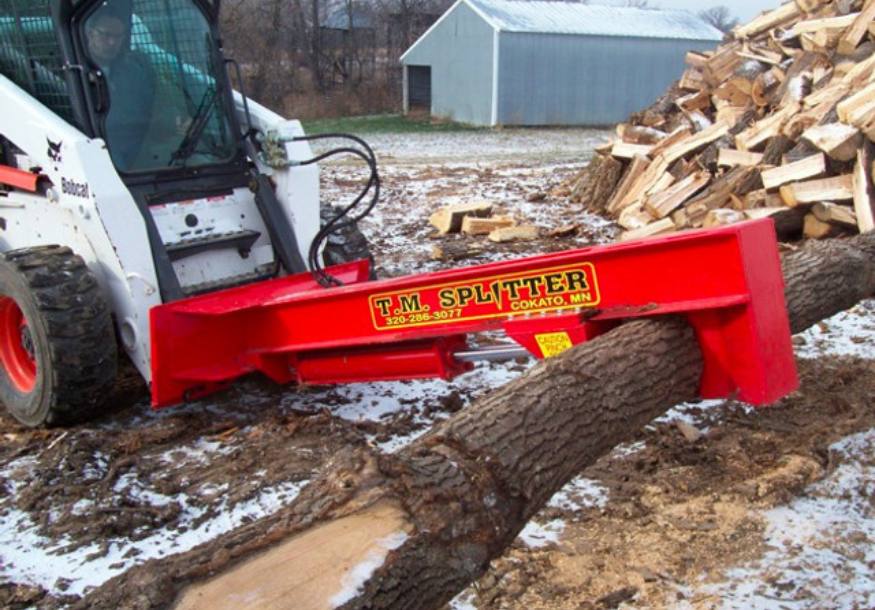Choosing the Right Log Splitter for Your Skid Steer
Posted by Hailey Miller on 17th Sep 2024
When it comes to splitting logs, whether for personal firewood or heavy-duty commercial applications, having the right equipment is essential. A skid steer log splitter attachment transforms your machine into a powerful log processing tool, allowing you to split even the toughest woods with ease. However, choosing the right log splitter for your needs can be overwhelming. From log size and splitter tonnage to portability and maintenance, there are several factors to consider.
In this comprehensive guide, we’ll answer some of the most common questions customers have about log splitters. We’ll also break down the key features of the top log splitters available this season, so you can make an informed decision when purchasing your next attachment.
What Size Logs Can a Log Splitter Handle?
One of the most frequent questions customers ask is about the size of logs a splitter can handle. The size of the logs you’ll be working with is a critical factor in determining which log splitter is best for you. Log splitters are categorized by the force they can apply—measured in tons—and the diameter and length of logs they can effectively split.
Here’s a simple guide:
Smaller Logs (Under 20 inches in diameter):
If you’re primarily splitting smaller logs, typically under 20 inches in diameter, a log splitter with lower tonnage (25-30 tons) is generally sufficient. This range is ideal for residential use, firewood splitting, and lighter jobs where the wood isn’t particularly tough or dense. These machines are perfect for softwoods such as pine or birch.
For instance, the Blue Diamond 25 Ton Log Splitter is an excellent choice for homeowners or light commercial work. It provides ample power for splitting softer wood without overkill.
Medium to Large Logs (20-36 inches in diameter):
For larger logs—those ranging from 20 to 36 inches in diameter—you’ll need more power. A 30-35 ton splitter is better suited for these tasks, especially when working with hardwoods like oak, hickory, or ash. These machines are built for landscapers, contractors, or anyone needing a tool that can handle higher volumes of logs efficiently.
The Top Dog 36" Log Splitter is designed for handling bigger jobs, offering the capability to split logs up to 36 inches in diameter. This makes it ideal for professionals needing to process large quantities of wood quickly and efficiently.
Extra-Large Logs (Over 36 inches in diameter):
When dealing with logs larger than 36 inches in diameter, particularly tough or dense hardwoods, you’ll need a heavy-duty splitter with over 35 tons of force. These splitters are designed for the most demanding jobs and are often used in commercial forestry, large-scale landscaping, and land clearing operations.
The TM Warrior Skid Steer Log Splitter offers incredible power, built for tackling the largest and most difficult logs. Its rugged design makes it a favorite among professionals who need serious power.
How Powerful Should Your Log Splitter Be?
The power of a log splitter is typically measured in tons of force. This force determines how efficiently the splitter can drive its wedge through a log. Understanding the level of force you need depends largely on the type of wood you’ll be splitting and how frequently you’ll be using the machine.
Here’s a breakdown of the tonnage required for different types of jobs:
25 Tons:
For splitting softer woods like pine, birch, and other light varieties, a 25-ton log splitter is more than enough. These machines are ideal for homeowners or light commercial work where the wood being split doesn’t require high levels of force.
The Blue Diamond 25 Ton Log Splitter is a great example of a splitter that delivers excellent performance for lighter tasks. It's well-suited for operators who need to split smaller logs regularly but don’t want to invest in an overpowered machine.
35 Tons:
If your work involves tougher hardwoods such as oak, hickory, or maple, you’ll need a splitter with at least 35 tons of force. This level of power is necessary for efficiently processing larger, denser logs.
The Blue Diamond 35 Ton Inverted Log Splitter is designed for tougher jobs, offering the necessary force to break through thick, heavy logs without breaking a sweat.
35+ Tons:
For commercial operations or heavy-duty use, a splitter with over 35 tons of force is recommended. These machines are built for the most demanding applications, such as splitting large volumes of logs, clearing land, or processing tough hardwoods for industrial use.
For example, the TM Warrior Skid Steer Log Splitter is a high-capacity option that provides the power and durability needed for large-scale tasks. This model is favored by professionals who require a machine capable of handling the toughest jobs day in and day out.
What Kind of Maintenance is Required for a Log Splitter?
Regular maintenance is crucial to keeping your log splitter in peak condition. Fortunately, skid steer log splitter attachments are generally low-maintenance, but there are a few key areas to pay attention to. Keeping up with basic maintenance will ensure your splitter performs well and lasts for years to come.
Hydraulic Fluid Checks:
Your log splitter operates using hydraulic power, so it’s essential to regularly check the hydraulic fluid levels. Low fluid levels can lead to poor performance and, in the long run, damage the hydraulic system. Make it a habit to check the levels before each use and top off the fluid as needed.
Inspect and Replace Worn Hoses:
Over time, the hydraulic hoses on your log splitter can become worn or cracked. Regularly inspecting the hoses for signs of wear can help you catch issues before they lead to leaks or malfunctions. If you notice any damage, replace the hoses immediately.
Engine Maintenance (for gas-powered splitters):
If you’re using a gas-powered log splitter, it’s important to maintain the engine just as you would with any other gas-powered equipment. This includes checking and changing the oil, replacing the air filter, and ensuring the engine is serviced according to the manufacturer’s recommendations.
Sharpen or Replace the Splitting Wedge:
The splitting wedge is a critical component of your log splitter. Over time, the wedge can become dull, making it less effective at splitting logs. Regularly sharpening or replacing the wedge will ensure the splitter maintains its cutting efficiency.
Splitters like theTM Pro-2 are designed with durability in mind, offering minimal maintenance while maximizing longevity. Hydraulic splitters are built to last, but staying on top of these small tasks will ensure optimal performance over time.
How Portable is the Log Splitter?
Portability is another crucial consideration, especially if you’re working on larger properties or job sites where you need to move the log splitter frequently. Skid steer log splitters are inherently portable since they attach to your skid steer, but the ease of use and attachment options can vary between models.
Skid Steer-Mounted Splitters:
Since these splitters are attached directly to your skid steer, they offer a level of portability that traditional standalone splitters can’t match. Instead of towing or transporting a heavy splitter, you simply move it along with your skid steer, allowing you to work in various locations without added hassle.
The TM Heavy Duty Skid Steer Log Splitter is designed with portability in mind. It easily attaches to your skid steer and can be moved around the job site with minimal effort.
What is the Cycle Time?
Cycle time refers to how long it takes for the log splitter to complete a full cycle, from extending the splitting wedge to retracting it. Faster cycle times mean more logs can be split in a shorter period, which is especially important for larger jobs or commercial operations where efficiency is key.
Fast Cycle Times for High-Volume Jobs:
If you’re processing a large volume of logs, you’ll want a splitter with a fast cycle time. Machines like the TM Pro Skid Steer Log Splitter are designed with speed to maximize productivity, making them ideal for high-volume operations. These fast-cycle log splitters allow you to split more logs in less time, which can be a game-changer for professionals who need to get through a lot of material quickly. The TM Pro Skid Steer Log Splitter’s rapid cycle times make it one of the best choices for commercial use where time is money.
Average Cycle Times for Residential Use:
For those splitting logs at home or for light-duty work, cycle times aren’t as critical. In these cases, a splitter like the Blue Diamond 25 Ton Log Splitter offers ample speed without overwhelming you with fast cycles that may not be necessary for smaller jobs. These machines are still efficient but better suited for users who don’t need to rush through large quantities of logs.
Can This Log Splitter Handle Both Seasoned and Green Wood?
Another key consideration is whether the log splitter can handle both seasoned and green wood. Seasoned wood tends to be drier and easier to split, while green wood is freshly cut, contains more moisture, and is often tougher to break apart.
Splitters for Seasoned Wood:
If you’re primarily splitting seasoned, drier wood, lower-tonnage splitters will work just fine. These splitters don’t need to exert as much force to cut through seasoned logs, making them more efficient for residential use. The Blue Diamond 25 Ton Log Splitter excels in these scenarios, offering enough power to split seasoned logs without unnecessary force or wear on the machine.
Splitters for Green Wood:
When it comes to green wood, more force is required to overcome the moisture content and density of the fresh logs. In these cases, higher-tonnage splitters like the TM Warrior and theTM Pro-2 are the best choices. These machines are built to handle the extra resistance that green wood provides, allowing you to efficiently split even the toughest logs.
Horizontal vs. Vertical Log Splitters: Which is Right for You?
When shopping for a log splitter, one key factor to consider is whether you need a horizontal or vertical splitter. Each type has its pros and cons depending on the size and weight of the logs you're dealing with, as well as how you prefer to work.
Horizontal Log Splitters:
In a traditional horizontal log splitter, the machine is positioned perpendicular to the ground. This means you place the log onto the beam, and the wedge moves horizontally to split the wood. Horizontal splitters are ideal for lighter, smaller logs because you can easily lift them onto the splitter.
Advantages of Horizontal Log Splitters:
- Ease of use for smaller logs: These splitters are great if you're working with smaller logs, as they can be easily loaded onto the splitter beam.
- Stable operation: The horizontal design ensures logs stay in place during splitting, especially for more uniform-sized logs.
Disadvantages:
- Manual log handling: If you're working with larger or heavier logs, the need to lift them onto the splitter can be physically taxing, making this setup less ideal for large logs.
For example, a splitter like the Blue Diamond 25 Ton Log Splitter is a horizontal model designed to handle smaller to medium-sized logs with ease, making it ideal for homeowners or small-scale projects.
Vertical Log Splitters:
Vertical log splitters, on the other hand, are designed so the log stands upright, and the wedge moves downward to split it. This design allows you to work with larger, heavier logs because you don’t have to lift them onto the beam—just roll them into place. Vertical splitters are often found in high-power, heavy-duty models, making them great for handling larger logs.
Advantages of Vertical Log Splitters:
- Handles large, heavy logs: Vertical splitters make it easier to split large logs since you can simply roll them into place without lifting.
- Less physical strain: Since there's no need to lift the log onto the splitter, vertical splitters significantly reduce strain on the operator, especially for commercial use.
Disadvantages:
- Limited by ground conditions: If you're working on uneven or rough terrain, it can be more difficult to position and stabilize logs for splitting.
The TM Warrior is a great example of a vertical log splitter attachment for your skid steer. It allows you to work with large logs without the physical strain of lifting, making it a perfect choice for professional users who need to process high volumes of heavy wood.
Inverted Log Splitters:
A variation of the vertical splitter is the inverted log splitter, where the splitting mechanism faces downward, allowing you to operate the machine while staying in the cab of your skid steer. The Blue Diamond 35 Ton Inverted Log Splitter is a popular option in this category, designed for convenience and maximum efficiency. Inverted splitters allow you to stay seated, making them ideal for operators who need to split large logs quickly and efficiently without leaving their skid steer.
Advantages of Inverted Log Splitters:
- Stay in the cab: Operators can remain in their skid steer while using the splitter, which is especially convenient for large-scale operations.
- Ideal for large logs: Like vertical splitters, inverted models eliminate the need for heavy lifting and can handle the largest logs with ease.
What Log Splitter Should You Look at This Season?
Choosing the right log splitter ultimately comes down to balancing your power needs with your budget and the type of work you plan to do. Luckily, there are some excellent models available this season that cater to a wide range of needs.
CID Skid Steer Log Splitter:
The CID Skid Steer Log Splitter is a solid all-around option, providing the right balance of affordability and performance. It’s great for smaller to medium-sized logs and is an excellent choice for homeowners or light commercial use. If you need an entry-level splitter that gets the job done without unnecessary bells and whistles, this is a great pick.
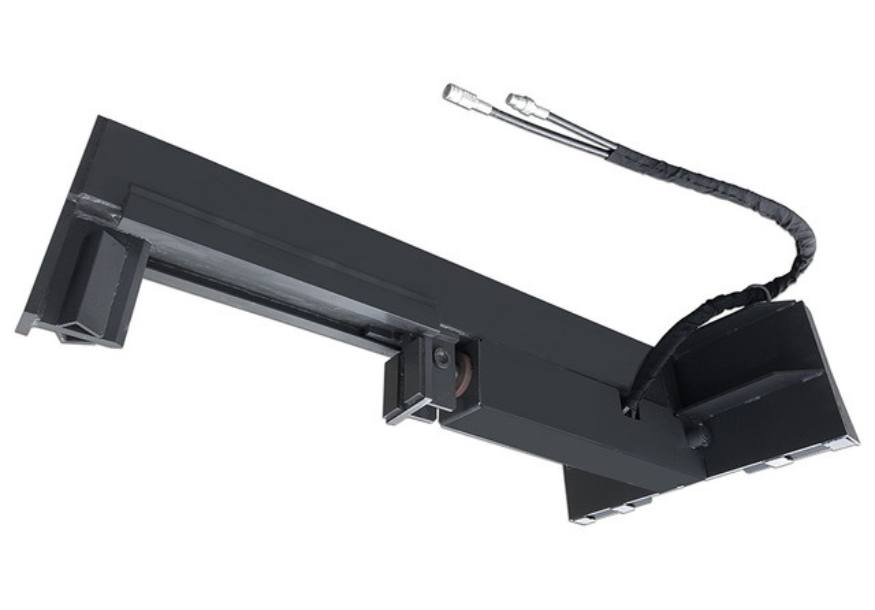
Blue Diamond 35 Ton Inverted Log Splitter:
With 35 tons of force, the Blue Diamond 35 Ton Inverted Log Splitteris perfect for splitting tough hardwoods and large logs. Its inverted design allows for maximum control and precision, enabling the operator to split logs without leaving the cab of the skid steer. This feature makes it ideal for professional operators who need to work efficiently.
TM Warrior Skid Steer Log Splitter:
The TM Warrior is one of the most powerful splitters available this season. It’s perfect for commercial operations or anyone dealing with extremely large or tough logs. If you’re looking for durability, power, and long-term performance, the TM Warrior is an excellent investment.
TM Pro Skid Steer Log Splitter:
For those who need speed without sacrificing power, the TM Pro Skid Steer Log Splitter is a top-tier choice. Its fast cycle times make it perfect for high-volume operations, and it offers the durability needed for commercial jobs.
Conclusion
Choosing the right log splitter for your skid steer depends on a variety of factors, including the size and type of logs you plan to split, the power you need, and how often you’ll be using the machine. Whether you’re splitting smaller, seasoned wood for residential use or tackling large, green logs in a commercial setting, there’s a skid steer log splitter attachment that’s perfectly suited for your needs.
- For smaller jobs and light commercial work, the CID Skid Steer Log Splitter or the Blue Diamond 25 Ton Log Splitter provide affordable, functional solutions.
- If you’re dealing with tougher, larger logs or professional applications, the Blue Diamond 35 Ton Inverted Log Splitteroffers the power and ease of use to handle difficult jobs from the comfort of your skid steer cab.
- For the most demanding jobs, the TM Warrior and TM Pro models provide unmatched power and speed, ensuring you can handle high volumes and heavy-duty tasks with ease.
By evaluating your needs and selecting the right equipment, you can ensure your skid steer log splitter is a reliable and efficient tool for years to come. With the right attachment, you’ll save time, effort, and increase productivity, whether you’re splitting wood for personal use or running a large-scale operation.






